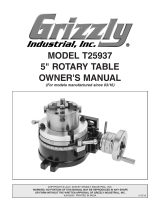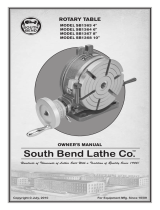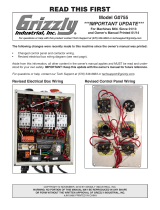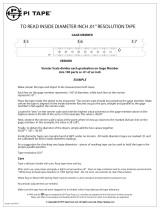Page is loading ...

MODEL H7506
HORIZONTAL/VERTICAL
ROTARY INDEXING TABLE
w/CHUCK
OWNER'S MANUAL
WARNING: NO PORTION OF THIS MANUAL MAY BE REPRODUCED IN ANY SHAPE
OR FORM WITHOUT THE WRITTEN APPROVAL OF GRIZZLY INDUSTRIAL, INC.

This manual provides critical safety instructions on the proper setup,
operation, maintenance and service of this machine/equipment.
Failure to read, understand and follow the instructions given in this
manual may result in serious personal injury, including amputation,
electrocution or death.
The owner of this machine/equipment is solely responsible for its
safe use. This responsibility includes but is not limited to proper
installation in a safe environment, personnel training and usage
authorization, proper inspection and maintenance, manual availability
and comprehension, application of safety devices, blade/cutter integ-
rity, and the usage of personal protective equipment.
The manufacturer will not be held liable for injury or property damage
from negligence, improper training, machine modifications or misuse.
Some dust created by power sanding, sawing, grinding, drilling, and
other construction activities contains chemicals known to the State
of California to cause cancer, birth defects or other reproductive
harm. Some examples of these chemicals are:
• Lead from lead-based paints.
• Crystalline silica from bricks, cement and other masonry products.
• Arsenic and chromium from chemically-treated lumber.
Your risk from these exposures varies, depending on how often you
do this type of work. To reduce your exposure to these chemicals:
Work in a well ventilated area, and work with approved safety equip-
ment, such as those dust masks that are specially designed to filter
out microscopic particles.

INTRODUCTION ............................................................................................................................... 2
SECTION 1: SAFETY ....................................................................................................................... 4
SECTION 2: SETUP ......................................................................................................................... 6
SECTION 3: OPERATIONS ........................................................................................................... 15
SECTION 4: ACCESSORIES ......................................................................................................... 22
SECTION 5: MAINTENANCE......................................................................................................... 24
SECTION 6: PARTS ....................................................................................................................... 26
WARRANTY AND RETURNS ........................................................................................................ 29
Table of Contents

INTRODUCTION
Contact Info
Rotary Table
Description
Manual Accuracy
your rotary table may not exactly match
the manual
www.grizzly.com

Identification
NOTICE
If you have never used this type of rotary table or equipment before, WE STRONGLY RECOM-
MEND that you read books, review industry trade magazines, or get formal training before begin-
ning any projects. Regardless of the content in this section, Grizzly Industrial will not be held
liable for accidents caused by lack of training.
Figure 1.

Safety Instructions for Machinery
4. ALWAYS USE HEARING PROTECTION
WHEN OPERATING MACHINERY.
Machinery noise can cause permanent
hearing loss.
5. WEAR PROPER APPAREL. DO NOT
wear loose clothing, gloves, neckties, rings,
or jewelry that can catch in moving parts.
Wear protective hair covering to contain
long hair and wear non-slip footwear.
6. NEVER OPERATE MACHINERY WHEN
TIRED OR UNDER THE INFLUENCE OF
DRUGS OR ALCOHOL. Be mentally alert
at all times when running machinery.
1. READ ENTIRE MANUAL BEFORE
STARTING. Operating machine before
reading the manual greatly increases the
risk of injury.
2. ALWAYS USE ANSI APPROVED
SAFETY GLASSES WHEN OPERATING
MACHINERY. Everyday eyeglasses only
have impact resistant lenses —they are
NOT safety glasses.
3. ALWAYS WEAR A NIOSH APPROVED
RESPIRATOR WHEN OPERATING
MACHINERY THAT PRODUCES DUST.
Most types of dust (wood, metal, etc.) can
cause severe respiratory illnesses.
For Your Own Safety, Read Instruction
Manual Before Operating this Machine
The purpose of safety symbols is to attract your attention to possible hazardous conditions. This
manual uses a series of symbols and signal words intended to convey the level of importance
of the safety messages. The progression of symbols is described below. Remember that safety
messages by themselves do not eliminate danger and are not a substitute for proper accident
prevention measures.
Indicates a potentially hazardous situation which, if not avoided,
MAY result in minor or moderate injury. It may also be used to alert
against unsafe practices.
Indicates a potentially hazardous situation which, if not avoided,
COULD result in death or serious injury.
Indicates an imminently hazardous situation which, if not avoided,
WILL result in death or serious injury.
This symbol is used to alert the user to useful information about
proper operation of the machine.
NOTICE
Safety Instructions for Machinery
SECTION 1: SAFETY

7. ONLY ALLOW TRAINED AND PROP-
ERLY SUPERVISED PERSONNEL TO
OPERATE MACHINERY. Make sure
operation instructions are safe and clearly
understood.
8. KEEP CHILDREN/VISITORS AWAY.
Keep all children and visitors away from
machinery. When machine is not in use,
disconnect it from power, lock it out, or
disable the switch to make it difficult for
unauthorized people to start the machine.
9. UNATTENDED OPERATION. Leaving
machine unattended while its running
greatly increases the risk of an accident or
property damage. Turn machine Off and
allow all moving parts to come to a com-
plete stop before walking away.
10. DO NOT USE IN DANGEROUS
ENVIRONMENTS. DO NOT use machin-
ery in damp, wet locations, or where any
flammable or noxious fumes may exist.
11. KEEP WORK AREA CLEAN AND WELL
LIGHTED. Clutter and dark shadows may
cause accidents.
12. USE A GROUNDED POWER SUPPLY
RATED FOR THE MACHINE AMPERAGE.
Grounded cords minimize shock hazards.
Operating machine on an incorrect size of
circuit increases risk of fire.
13.
ALWAYS DISCONNECT FROM POWER
SOURCE BEFORE SERVICING
MACHINERY. Make sure switch is in
OFF
position before reconnecting.
14. MAINTAIN MACHINERY WITH CARE.
Keep blades sharp and clean for best and
safest performance. Follow instructions for
lubricating and changing accessories.
15. MAKE SURE GUARDS ARE IN PLACE
AND WORK CORRECTLY BEFORE
USING MACHINERY.
Safety Instructions for Machinery
16. REMOVE CHUCK KEYS OR ADJUSTING
TOOLS. Make a habit of never leaving
chuck keys or other adjustment tools in/on
the machine—especially near spindles!
17. DAMAGED MACHINERY. Check for bind-
ing or misaligned parts, broken parts,
loose bolts, other conditions that may
impair machine operation. Always repair or
replace damaged parts before operation.
18. DO NOT FORCE MACHINERY. Work at
the speed for which the machine or acces-
sory was designed.
19. SECURE WORKPIECE. Use clamps or
a vise to hold the workpiece when practi-
cal. A secured workpiece protects your
hands and frees both hands to operate the
machine.
20. DO NOT OVERREACH. Maintain stability
and balance at all times when operating
machine.
21. MANY MACHINES CAN EJECT
WORKPIECES TOWARD OPERATOR.
Know and avoid conditions that cause the
workpiece to "kickback."
22. STABLE MACHINE. Machines that move
during operations greatly increase the
risk of injury and loss of control. Verify
machines are stable/secure and mobile
bases (if used) are locked before starting.
23. CERTAIN DUST MAY BE HAzARDOUS
to the respiratory systems of people and
animals, especially fine dust. Be aware of
the type of dust you are exposed to and
always wear a respirator designed to filter
that type of dust.
24. EXPERIENCING DIFFICULTIES. If at
any time you are experiencing difficulties
performing the intended operation, stop
using the machine! Contact our Technical
Support Department at (570) 546-9663.

SECTION 2: SETUP
Description Qty
Page 7
Needed for Setup
please
immediately call Customer Service at (570) 546-
9663for advice.
Otherwise, filing a freight claim can be difficult.
Unpacking
SUFFOCATION HAZARD!
Immediately discard all plas-
tic bags and packing materi-
als to eliminate choking/suf-
focation hazards for children
and animals.
Wear safety glasses dur-
ing the entire setup pro-
cess!
Read through this entire
manual to become famil-
iar with the controls and
operations before using
this rotary table. Follow
all of the safety instruc-
tions in the owner's man-
ual for your mill.
This rotary table is very
heavy. Get lifting help and
use proper lifting meth-
ods to avoid possible
serious personal injury.

Inventory
Note: If you can't find an item on this list, check the
mounting location on the rotary table or examine
the packaging materials carefully. Occasionally
we pre-install certain components for shipping
purposes.
Inventory: (Figure 2) Qty
A.
B.
C.
D.
E.
F.
Figure 2.
Figure 3
For optimum performance, clean all moving
parts or sliding contact surfaces.
Clean Up
Gasoline and petroleum
products have low flash
points and can explode
or cause fire if used to
clean machinery. DO
NOT use these products
to clean the machinery.
Many cleaning solvents
are toxic if inhaled.
Minimize your risk by only
using these products in a
well ventilated area.
G2544—Solvent Cleaner & Degreaser
H9692—Orange Power Degreaser
Figure 3.

Mounting On Mill
Table
Surface CarePage
25
To mount the rotary table on the mill table:
1.
2.
Step 3
3.
Note: If the mill table T-slots are wider than
the alignment keys, push the rotary table
back so that both keys are firmly up against
the back of the mill table T-slot.
Figure 4
Aligning with Mill X-Axis Page
11
4.
Figure 4.

Installing T-Slot
Table
To install the T-slot table:
1.
2.
3.
Figure 5
Centering T-Slot
Table with Rotary
Table
To center the T-slot table with the rotary
table:
1.
2.
3.
4.
5. Steps 3–4
6.
Steps 2–4
Figure 5.

Centering Chuck
with Rotary Table
To center the chuck with the rotary table:
1.
2.
3.
Figure 7
Figure 7.
Installing Chuck
To install the chuck onto the rotary table:
1.
2.
3.
Figure 6
Figure 6.

4.
Figure 8
5.
6.
7.
8. Steps 5–7
9.
Figure 8.
Aligning with Mill
X-Axis
To align the rotary table with the X-axis with-
out the alignment keys:
1.
2.
Figure 9
Figure 9.
3.
4.
5.

4.
5.
Tip: Use a mirror to aid in reading the test
indicator as it rotates away from you.
6.
Note: When the workpiece key feature is
large enough, it may be easier to use an
edge finder instead of a test indicator.
Chuck Mounted Horizontally
1.
Figure 11
Figure 11.
2.
Figure 11
3.
4.
Centering with Mill
Spindle
Workpiece Mounted Horizontally On
T-Slot Table
1.
Figure 10
Figure 10.
2.
Note: Turn the rotary table in just one direc-
tion to eliminate the affect of backlash and for
accurate indicator results.
3.

Workpiece Mounted Vertically
1.
2.
Figure 12
Figure 12.
3.
4.
Note: Make sure you account for any back-
lash when moving the mill table.
Installing Spacer
Plate
To install a spacer plate:
1.
2.
Figure 13
Figure 13.
3.
Tip: If necessary, you can thread the M6-1 x
12 cap screws used with the alignment keys
into the two threaded holes in the back cover
to aid in removing it.

4.
Figures 14–15
Figure 15.
5.
6.
Figure 14.

SECTION 3: OPERATIONS
NOTICE
If you have never used this type of equip-
ment before, WE STRONGLY RECOMMEND
that you read books, review industry trade
magazines, or get formal training before
beginning any projects. Regardless of the
content in this section, Grizzly Industrial
will not be held liable for accidents caused
by lack of training.
Loose hair, clothing, or
jewelry could get caught
in machinery and cause
serious personal injury.
Keep these items away
from moving parts at all
times to reduce this risk.
Read through this entire
manual to become famil-
iar with the controls and
operations before using
this rotary table. Follow
all of the safety instruc-
tions in the owner's man-
ual for your mill.
Always wear safety
glasses when operating
this equipment.
Basic Controls
Figure 16
A. Indexing Lever:
B. Degree Scale:
C. Backlash Adjustment Wheel & Lock:
D. Vernier Scale:
Figure 16.

Indexing lever
Figure 17
Figure 17.
Table Movement
Table Lock Lever
E. Handwheel Scale:
F. Rotary Table Lock:

Degree Scale
Figure 18
To use the degree scale:
1.
2.
3.
4.
Figure 18.

Adjusting Vernier
Scale
Figure 20
Handwheel Scale
Figure
19
Figure 19.
Figure 20.
/






